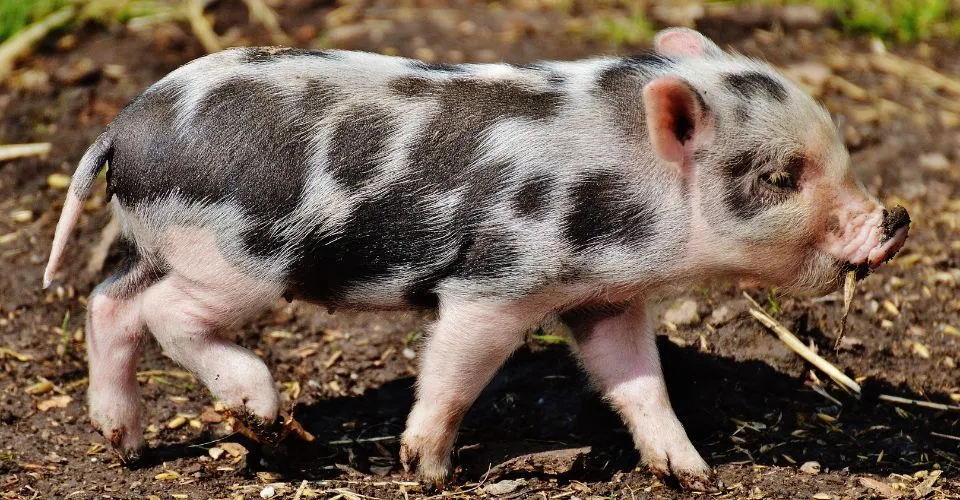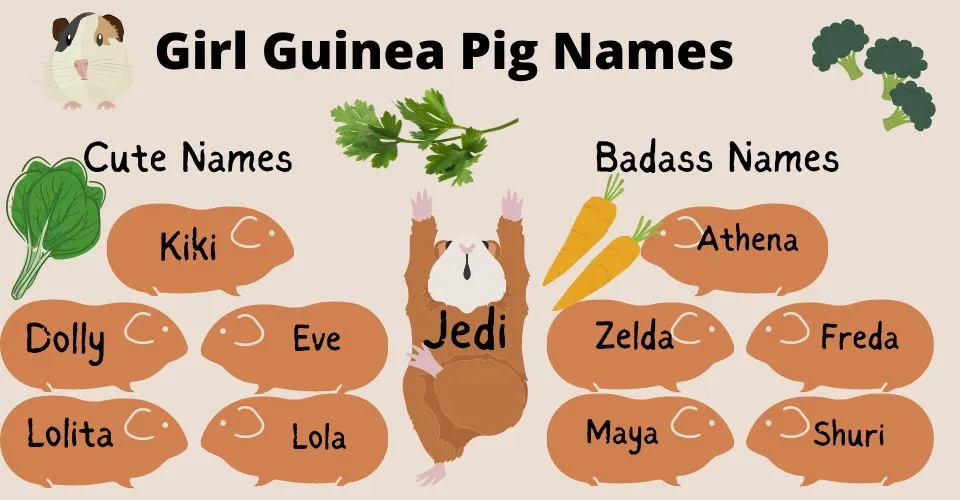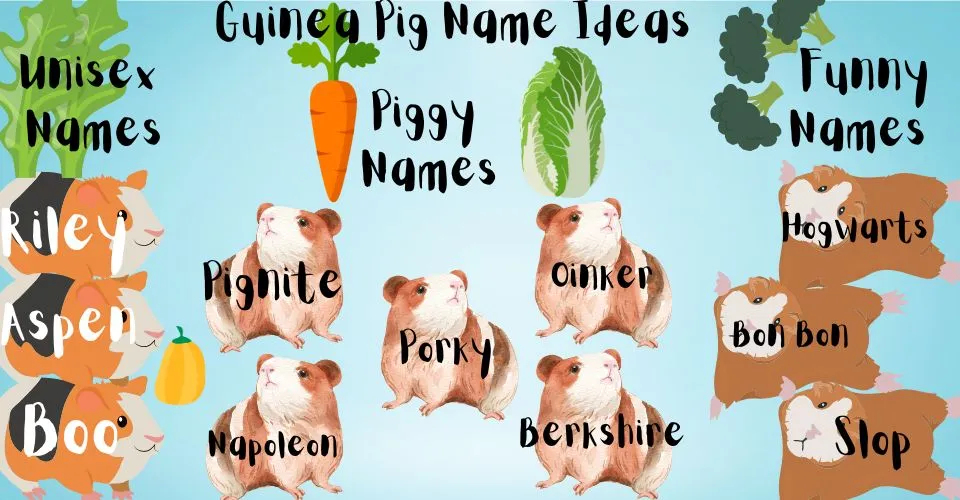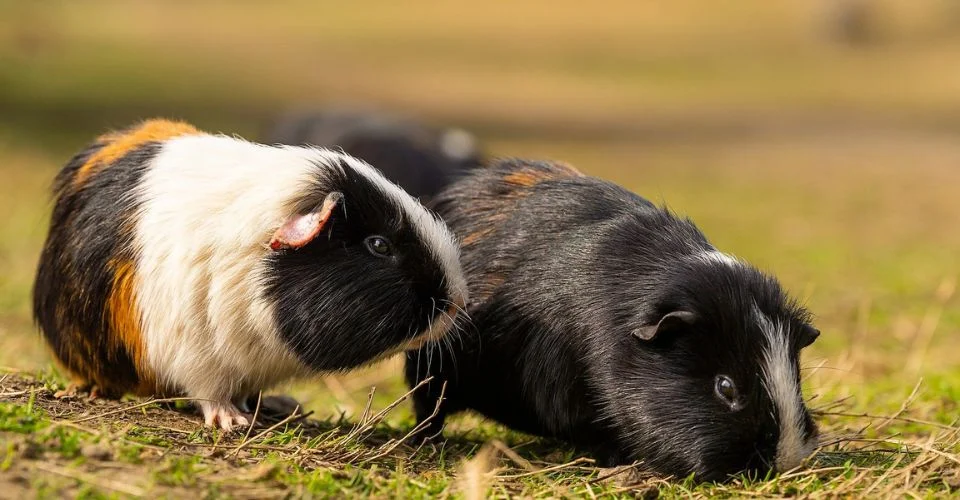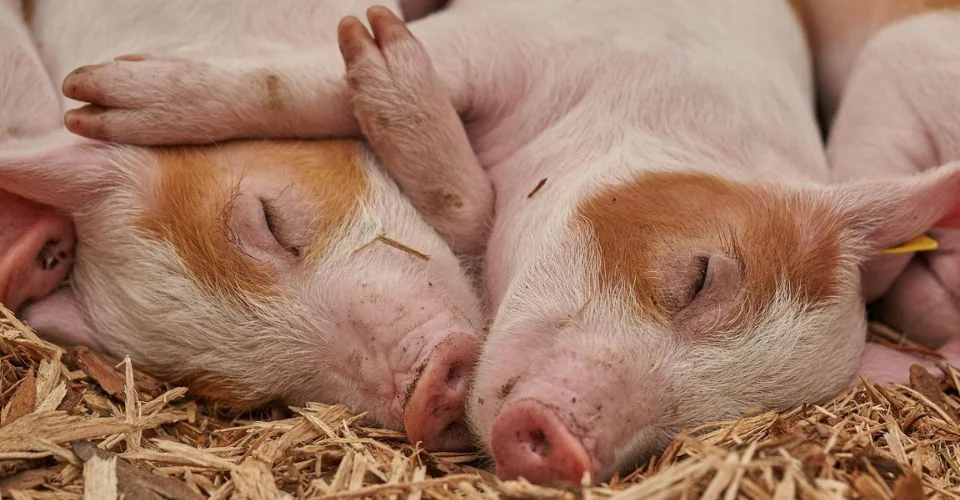Often called ‘mini pigs’ or ‘teacup pigs’ Juliana pigs are experiencing a surge in popularity in recent years. They are also referred to as miniature painted pigs because they have marvelous spotted bodies. Besides their miniature size, their popularity is also attributed to their intelligence, sociability, quirkiness, and gentle and affectionate nature.
Perhaps, you have also been fascinated by a cute funny video of a Julian pig on the internet, and now you are here to confirm if they are real and know if they will make a good pet for you. If so, continue reading as we are going to discuss it all about Julian Pigs.
Let’s have a quick look at the Juliana pig breed overview, before diving into the details.
Juliana Pig Overview
Juliana pigs have been developed by the cross-breeding of different small pig breeds and inbreeding. They are not yet officially recognized as a mini pig breed. Regardless, they are growing popular across the globe as pet piglets and are bred with other mini pig breeds like Kunekune.
| Juliana Pigs Breed Overview | |
| Scientific Name | Sus scrofa domesticus |
| Common Names | Mini, Micro, Pygmy, Teacup, Miniature painted pig |
| Origin | Europe |
| Height | 10 to 16 inches |
| Weight | 20 to 60 pounds |
| Lifespan | 15 to 20 years |
| Coat Color | Silver, black, rust, cream, red, or white body with black, red, or white spots |
| Eyes | Blue to black colored almond-shaped eyes |
| Habitat | Moist forests, swamps, regions with abundant reeds |
| Temperature | Regions with a cold environment. They are sensitive to extreme heat and cold |
| Temperament | Peaceful, quirky, highly intelligent, get bored easily, highly trainable |
| Suitable for | Households with fenced grazing areas, |
Juliana Pigs Origin and History
Just like other mix-breeds, not much-documented history is available on Julian pigs. Moreover, as they are not officially recognized as a breed, their origin is not truly known. That said, it is widely believed that these mini pigs were developed by farmers in Europe by mixing various miniature pig breeds. They were bred to be kept as pets on farms. Juliana pig breeders in the US import their breeding Juliana pigs (boars and sows) from Europe.
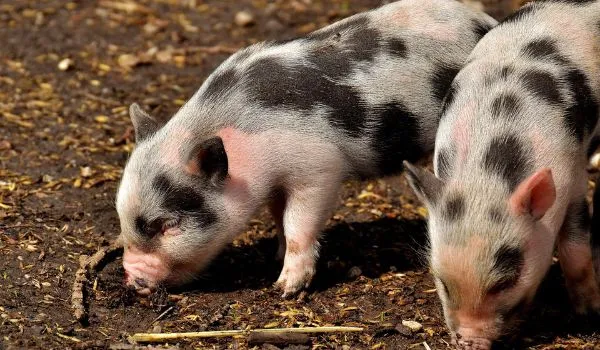
Juliana Pigs Temperament
Juliana pigs have a peaceful temperament. They are known for their high intelligence, energy, curiousness, and highly sociable nature. They love to hang around with their loving pet parents. In fact, some level of human interaction is crucial for Juliana pigs.
Do Juliana Pigs Make Good Pets?
Given their small size, sociable nature, and high intelligence, Juliana pigs make great pets. In fact, they are specifically bred to be kept as pets on farms and in houses. As they are intelligent, you can easily treat them how to get along with other pets and people in the house. You can also house-train them and teach them many skills as well. If socialized properly, they will be friendly toward all people around them, unless they feel threatened.
However, they require a lot of care and attention. Moreover, they also require some outdoor fenced areas, where they can graze freely.
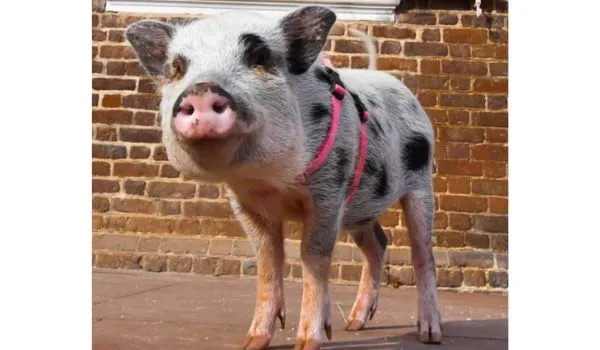
Can You Leave Juliana Pigs Alone? For How Long?
If you are going to bring home a Juliana Pig, you should remember that are not farm animals and are specifically bred to be kept as pets. So much like cats, dogs, and guinea pigs, they require regular care and human attention. So they should not be left alone for long times—more than four hours—or else they will develop anxiety and behavioral issues.
We advise that if you are a working pet parent and have to leave home and go to work all day long, you should reconsider your decision of getting a Juliana pig.
Do Juliana Pigs Like to Cuddle?
Yes, they do. Juliana pigs love to cuddle with their loving owners. In fact, one of the reasons behind the soaring popularity of these furballs is their love for cuddling. You can provide your Juliana pig with some warm and comfy blankets and cuddly toys to snuggle with.
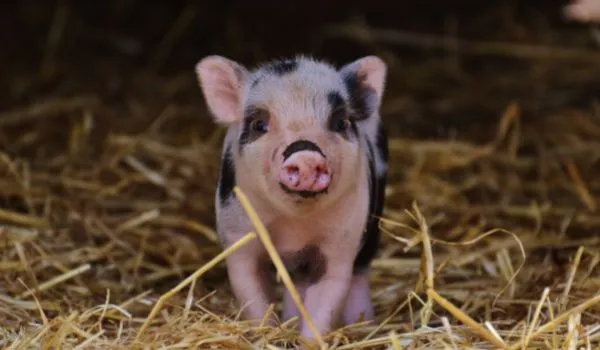
Do Juliana Pigs Get Attached to Humans?
Yes, Julian pigs are social animals and after spending some time, they establish strong bonds with their loving humans. They like it when they’re being pet and stroked, and massaged by their owners. Thus when left alone for a long time, they get upset and develop separation anxiety.
Juliana Pigs Appearance
Juliana pigs are small colorful creatures with spotted bodies. They have small but erect ears. Their eyes can be anywhere from blue to black and are almond-shaped. Their unique and most prominent feature is their heads—long and straight snouts (neither snubbed nor turned up). They have an athletic body—lean and muscular—and are a bit longer than tall.

Juliana Pigs Coat
The mini Juliana pigs have furry coats. They come in silver, black, rust, cream, red, or white-colored body. They also have spots all over their body, which gives them their name “miniature painted pigs.’ These spots are mostly white, red, or black in color. As their fur gets longer and these spots start fading away. But when you shave your Juliana pig in summer, the spotted pigmentation would be visible.
Though their thick fur helps them stay warm in cold winters their skin is still sensitive to extreme weather—both cold and heat.
Juliana Pigs Size
As Juliana pigs are developed by selective breeding and inbreeding of different small pigs, we cannot really say if your miniature piglet is going to retain its small stature.
How Big Do Juliana Pigs Get?
Juliana piglets are bred to be small pets with a size not over 40 pounds. While most micro pigs would max out at around 40 pounds, some may grow bigger. The maximum acceptable weight for Juliana pigs is 60 pounds. If your Juliana pig weighs more than 60 pounds, it cannot be considered a Juliana pig anymore. Other domestic pigs can grow much bigger than this.
That said, Juliana pigs have an average height of around 10 to 16 inches and their weight varies between 40 to 60 pounds.
Full Grown Juliana Pig
No Guarantees! There is no guarantee that your Juliana pig would retain its miniature size. It can grow well beyond, 65 pounds.
While Juliana pigs grow the most within their first year of life, they continue growing until three years of age. The maximum acceptable size of a full-grown Juliana pig is 60 pounds. If a Juliana pig is about 15 to 25 pounds, chances are he was underfed for most of his first year in this world.
Many people love the idea of having a micro piglet, so they bring home a Juliana pig. But when it starts weighing more than 30 pounds and goes beyond 60 pounds, they discard their pigs in shelters or the wild.
So before bringing home a Juliana pig, you should know that while the average size of Juliana pigs is 20 to 60 pounds, they can easily grow up to 80 pounds.
Juliana Guinea Pig Size Chart
Based on the growth data of Melvin, a Juliana pig purchased from New England Teacup Pigs, here is a Teacup pig growth chart. Before you make this chart a reference, you should know that different pigs grow differently. If you were to feed two Juliana pigs the same food in the same house, they may end up growing differently—one growing faster and bigger than the other.
| Age | Weight |
| 3 months | 7lbs |
| 8 months | 23 lbs |
| 10 months | 30.7 lbs |
| 1 year 2 months | 41.9 lbs |
| 2 years 2 months | 74 lbs |
| 2 years 6 months | 94.3 lbs |
| 2 years 11 months | 105 lbs |
| 3 years 6 months | 107 lbs |
| 3 years 11 months | 108 lbs |
From the above chart, you can see that Melvin gained weight rapidly in the first three years—about 30 pounds every month. But during a 3 to 4 years period, he gained only 3 pounds. From this, we can conclude that Melvin was fully grown by the age of 3 years.
Full-grown Melvin was about the size of a medium-sized dog weighing around 100 pounds. For reference, it is pertinent to mention here that Melvin was in perfect shape—neither overfed nor underfed.
Juliana Pig Care
Bringing home a Julian pig can be exciting and fun. But you should know that it comes with a lot of responsibility as well. You will not only have to provide them with a comfortable environment to live in but also have to provide them with regular meals and meet their grooming requirements.
Juliana Pig Diet
Like other pigs, Juliana pigs are omnivores. You will have to feed them a diverse diet—consisting of high-quality pellets, fresh fruits and vegetables, and leafy greens in moderation. Juliana pigs are often seen foraging for insects so maybe you can provide them with some insects.
What Should I feed My Juliana Pig?
Overall, 50% of a Juliana pig’s diet must consist of quality commercial pig pellets, and for the remaining half, you can feed your piggy fresh fruits, vegetables, and some other treats. You should also be feeding your mini pig supplements for skin and coat health.
That said, you should bottle-feed newborn piglets. You should always consult your vet about what food you should be feeding your petite furry friend.
What Not to Feed My Juliana Pig? • Salty foods such as chips • Coffee and Chocolate • A large amount of breakfast Cereal (may disturb calcium and phosphorus balance) • Un-pitted stone fruits (ingestion of pit can cause choking and intestinal blockage) • Unshelled nuts (sharp shell pieces can cause injuries) • Cat and dog foods (too high in proteins)
How Much Should I Feed my Juliana Pig?
While the exact amount of food you should be feeding your Juliana pig is dependent on the brand being fed, in general, adult Juliana pigs should be fed around 2% of their total body weight. You can also check the food box for feeding recommendations: most brands give feeding recommendations.
While your furry friend may eat more than the 2% if, given the chance, you should never feed him more. Eating more than that would cause obesity and related health problems like arthritis, and heart issues in your pig.
As far as treats are concerned, you should always first check their safety and then feed them occasionally and in moderation.
How Much Water Does a Juliana Pig Need?
Juliana pigs consume a lot of water. They drink around 5 to 20 liters of water every day. A pregnant Juliana pig would require around double the amount of water. All pigs even the nursing piglets should have access to clean and fresh water all the time as dehydration can make them sick and increase the risk of heatstroke—Juliana pigs are sensitive to extreme weather.
Our Juliana pigs are unable to sweat like us humans, so to cool off after an intensive activity or during warm weather, they need to drink water.
Watering Tip! Make sure that your Juliana pig’s water bowls cannot be tipped over. As these mini pigs have a tendency to play with their toys, you don’t want them to spill the water and make a mess.
What Kind of Home Does My Juliana Pig Need?
If you are planning on bringing home a Juliana pig, you need to provide shelter and a fenced roaming and grazing area. If you want to keep him inside the house, you will have to get him a crate, in which he can relax whenever he wants. Provide dry straw bedding in the outdoor pig shelter and for the indoor pig crate, you can provide a comfy blanket.
You will also have to be careful about the temperature as Juliana pigs are quite sensitive to extreme weather. Where extreme hot weather would cause dehydration and heatstroke in Juliana pigs, an extremely cold environment would cause pneumonia.
If you are keeping your Juliana pig inside, you will have to provide take them out for a morning walk and let them bask in the sunlight for a while. If they are kept outdoors, they can come out of their shelter and bask in sunlight as they please.
Pig Proof Your Home! Just like baby-proofing your house, you will have to pig-proof your house as well before bringing home a Juliana pig as they are quite intelligent and can quickly learn how to open kitchen cabinets. You should also have to shift potential toxins somewhere high, where your furry friend cannot reach them.
Juliana Pig Grooming
Juliana pigs are pretty clean animals and require their environment and themselves to be kept clean all the time. To keep them clean and tidy, you should bathe them, whenever necessary—they get smelly. As most pigs don’t like their bathing sessions, you can provide your piggy with a floating toy to keep busy. You should give your furry friend a nice scrub to get rid of the dead skin cells and rinse him thoroughly afterward.
Moreover, your Juliana pigs would also need their hooves, nails, and tusks to be trimmed every year. Trimming may seem like a daunting task to novice owners, therefore, you should leave it to the professionals.
Juliana Pigs Training
One of the great things about Juliana pigs is that they can be easily trained. Many Juliana pig owners have attested to the claim that Juliana pigs are very intelligent and thus easy to train. Many even say that they are easier to train than many dog breeds, given that you are generous with treats.
Can Juliana Pigs Be House-trained?
Yes, most certainly. Juliana pigs can be easily house-trained, but you will have to be patient and consistent, like house-training dogs. You can teach your furry friend to go to relieve himself either outside or inside the house in a litter box.
Do Juliana Pigs Make a Mess?
Although most pigs have a reputation for being dirty, Juliana pigs, like other miniature pigs, are quite clean pets. Pigs wallow in the mud, not for fun or because they like the mud, rather they do it to cool off in warm weather. As mentioned earlier, pigs don’t really sweat so they need to cool off by either drinking a lot of water, bathing in water, or jumping in muddy waters (whatever is available). So, if you don’t want your piggy friend to get dirty in the mud puddle, you should make sure that he has easy access to a water pool. Given the two options, Juliana pigs are going to prefer clean pool water over a muddy puddle.
Once potty trained, they will relieve themselves in the specified place. In fact, if an accident happens, your piggy friend will feel really bad.
Juliana Pig Lifespan: How long does a Juliana pig live?
Juliana pigs have an average lifespan of 12 to 20 years. Given that Juliana pigs are a mix of several mini pig breeds and are sometimes developed by inbreeding which often leads to the development of several health issues, they are known to have a shorter lifespan.
That said, records have shown that when kept with great care—well-fed, regular vet visits—Juliana pigs tend to live a longer and healthier life.
Where Can I Get a Juliana Pig?
Juliana Pigs are not the kind of pets that you can go and simply pick from a pet store. We believe in Adopt, not Shop. If you are thinking of bringing home a Juliana pig, you can check out local animal shelters, local animal rescue sanctuaries, or a pig placement network.
If you have no luck finding a Juliana pig in these places, you can contact a reputable Juliana pig breeder. While making the purchase, keep in mind that many sellers are deceiving novice pig keepers, by offering a piglet under the label of teacup pig, miniature pig, and Juliana pig. To be safe, you should ask a vet for a reference.
Moreover, you should always make sure that the pig that you are buying is not coming from a pig mill (they treat these cute piggies as a commodity and do not care for their well-being, all they care for is making money).
How Much Does a Juliana Pig Cost?
While you can get a Juliana piglet for around $1000 from a reputable breeder. However, depending on the quality of the piglet and breeder, their price may vary between $1000 to $6500. Additionally, you will also have to pay some pig adoption fees, which could be another $100 to $200.
Can You Farm Juliana Pigs on Small Scale?
Given that Juliana Pigs are specifically bred to be kept as pets either on farms or in houses, they cannot be farmed, not even on small scale. And given the petite size of these mini pigs, there would be very little produce so what’s the point?
Should I Get My Juliana Pig Spayed or Neutered?
Intact, Juliana pigs, especially male pigs get really big and oftentimes aggressive as they mature. Therefore, they should be neutered at a young age. The neutering procedure must be carried out by a professional. Spaying a female is a bit difficult and you might face difficulties in finding a vet who is willing to perform the spaying procedure on your female Juliana pig.
If you are bringing home a pair of male and female pigs, You should get the male boar neutered if you don’t want them to breed. A Julian pig sexually matures at the tender age of three months, many breeders breed their three-month babies and then deceive potential buyers by labeling the three-month-old pregnant pigs as mature. They try to make the sale by giving buyers the false sense that Juliana pigs stay small even in adulthood.
A Juliana pig can have around 14 piglets. Fourteen piglets may sound cute and adorable but caring for 14 piglets or finding a good home for each one of them is next to impossible. Therefore, it is best that you neuter your piglet before it reaches sexual maturity and impregnates the female.
Should You Get a Juliana Pig or Not?
If you have not yet made up your mind about getting a Juliana pig, the following pros and cons may help you make the right decision.
| Juliana Pigs Pros and Cons | |
| Why You Should Get a Juliana Pig? | Why You Should Not Get a Juliana Pig? |
| They are highly intelligent—they can learn how to open kitchen cabinets | Their intelligence and curious nature might get them in trouble |
| They are clean pets—much cleaner than most dogs and cats | They may not retain their small size—they keep growing until three years of age |
| They can be litter trained, If living outside, they will always relieve themselves in one spot | They will root up your garden |
| They are highly social and need regular social interactions with their humans. | On the flip side, they can develop separation anxiety when left alone for a long time. |
Juliana Pig Facts
To finish off the topic, below we have listed some of the most interesting facts about Juliana Pigs.
Juliana Pigs Facts • They are known by many names including mini pigs, micro pigs, teacup pigs, and miniature painted pigs. • They have interesting black, red, or white spots on their body, which fade as they grow long fur. • They are highly intelligent and can be house trained. • They are extremely social and develop strong bonds with their owners. When left alone, they develop separation anxiety. • Like other pigs, they don’t sweat and thus need water to cool off. • When Juliana pigs are excited or in motion, their tail often curls.
